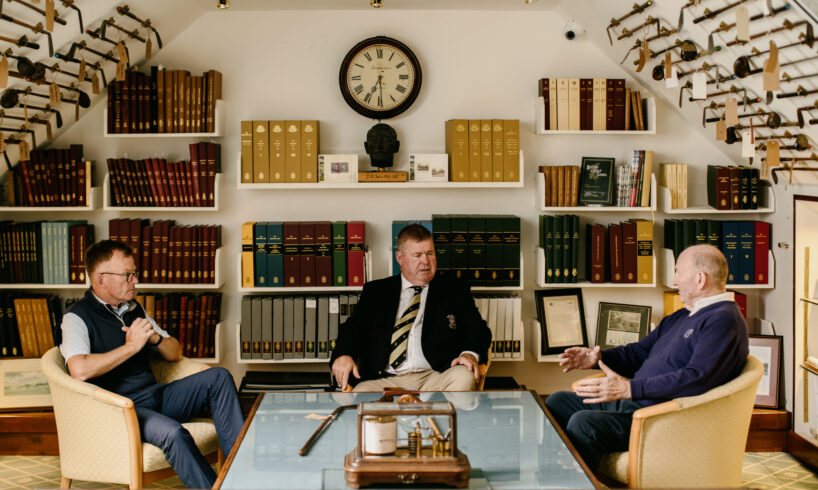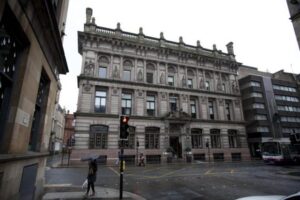
(Image: NQ Staff)
How did the club come to have a dedicated archive?
The current clubhouse at Nairn was opened in 1991, with the Bulmer extension added in 1997, which included a marvellous circular meeting and function room along with extra storage space above the then newly-created pro shop.
A variety of collected or donated artefacts and memorabilia from times gone by were deposited there, but were soon gathering dust. Eventually, after a very late night at the Walker Cup over in County Down, a few past Nairn captains came up with the idea of putting together a collection of the club’s heritage and very quickly our beloved and esteemed archive room took hold!
What’s there to see?
We must have over a thousand items of Nairn heritage on display, with the same again in external storage. We rotate what is being displayed depending upon who might be visiting, or whether we are hosting a particular R&A or North District event.
For example, the other month the grandson of an early past captain, Frank Fairlie, contacted us to say he was over from Australia and would love to learn more about his family’s connection with the golf club and surrounding community, to which we were only too pleased to bring out a variety of documents and artefacts relating to his predecessors including great-grandad James Ogilvie Fairlie, who was instrumental in the relocation of Old Tom Morris to Prestwick, culminating in the first Open coming to fruition.
Who can access the archive?
Members and their guests are encouraged to spend time there whenever so desired, and visitors can access at zero cost via appointment with myself or our golf operations team – we just love to show off all that’s on offer. It’s not to be missed when visiting Nairn, along with a customary dram of Tomatin.
Tell us about the Ben Hogan putter.
The Hogan Putter was very kindly donated by Frank Rennie, the then long-time professional at Prestwick. Thankfully Frank was aware of a bond between Hogan and a previous Nairn professional, Jimmy Adams, that dated back to 1947 when the American beat Adams in a Ryder Cup match over in Portland, Oregon.
“You’re a far better striker of a golf ball than you are a putter, try this…” he said, handing over a much tournament-played MacGregor putter. The club is now one of our prized possessions, and the story that goes with it is just as priceless.
So what is the collection worth?
I wouldn’t like to guess the value as the vast majority of the artefacts are one-offs, and many irreplaceable, but there are also numerous very insignificant items of only nominal value that have great stories to accompany them.
My favourite relates to the simple hickory stymie stick, which goes back to match play golf prior to 1952 when balls weren’t generally allowed to be moved or marked unless they were blocked/snookered within six inches of an opposition ball.
Mr Sutherland says the ‘vast majority’ of the items are one-offs(Image: Nairn GC)
What is the club’s connection to the Walker Cup?
Nairn was extremely fortunate to be invited to host the 1999 Walker Cup, which was probably one of the biggest sporting events ever to hit the Highlands.
The club welcomed the occasion with open arms and much gusto. The home team included the likes of Luke Donald and Paul Casey who quickly sent Matt Kuchar & Co back across the pond to think again – some really great memories.
Thirteen years later the female equivalent, the Curtis Cup, came up north, resulting in Nairn being the only GB&I club to have hosted both Walker and Curtis Cup winning teams.
From how far back do the club records date?
Club records go way back long before its formation in 1887, when Aberdeen greenkeeper Andrew Simpson agreed to design the original 18-hole layout which was later tweaked by both Messrs Morris and Braid, and more recently by Mackenzie & Ebert prior to our hosting of The Amateur and Women’s Amateur Championships in 2021 and 2025.
All the club’s minutes and written documents are still carefully and traditionally bound, whilst various members’ tales are transcribed onto walls and ceilings. Among these is a suggestion to a pre-1900 committee that maybe ladies should be allowed into what was then the gentlemen’s clubhouse if the temperature dropped below zero. I am at a loss to remember how that was eventually dealt with.
And what about the Sabbath sticks?
We have an interesting selection of Sabbath sticks, which date back to 200 years ago when very little golf played anywhere throughout Scotland on a Sunday due to religious laws.
Those that could afford to have custom-made golf-styled walking sticks were able to overcome such restrictions. There are half-a-dozen such sticks amongst our collection, which we dearly cherish and are happy to show to our visitors.





